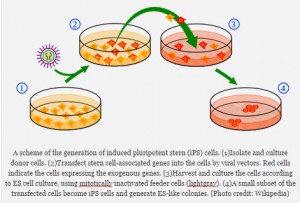We’ve known for some time that pluripotent stem cells can become almost any type of cell in the human body. Working with these cells means scientists can experiment with drugs and study diseases on real human cells that are not attached to a real human being. They can learn so much without ever endangering or harming a person. These amazing cells are also responsible for the growing field of regenerative medicine in which researchers look for ways to restore lost or damaged organs and tissues.
Now scientists have discovered a new type of stem cell they have created in the lab from mouse cells and can engineer into any type of stem cell they want. They’re called F type (can you believe it? – they call them “F” because these cells tend to hang out in “fuzzy” colonies). It will take a lot more money and research to see what they can accomplish with the F type, but this points the way to the potential for discovering other classes of stem cells.
Almost limitless. That’s what stem cell research begins now to look like in earnest.
Related articles

















